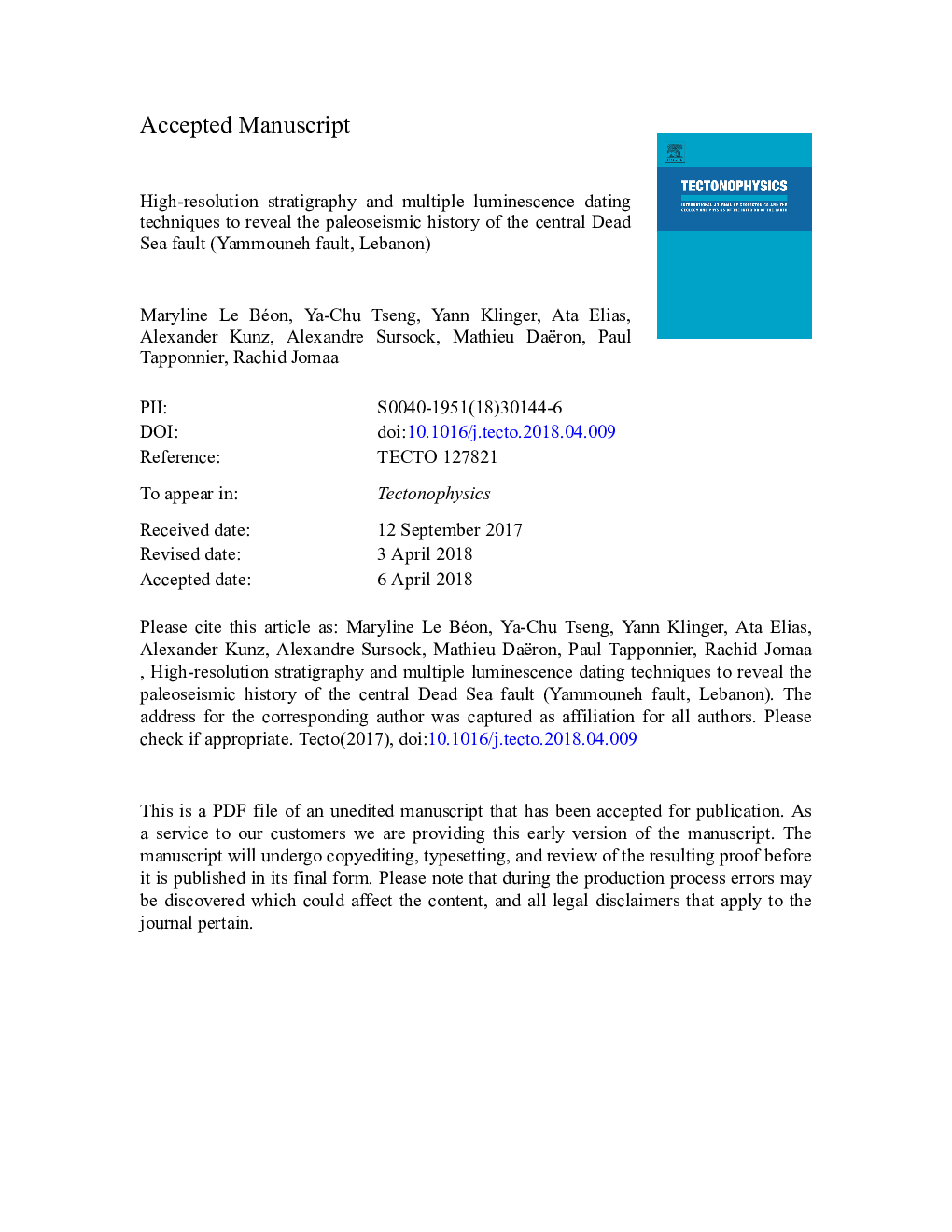| کد مقاله | کد نشریه | سال انتشار | مقاله انگلیسی | نسخه تمام متن |
|---|---|---|---|---|
| 8908644 | 1636675 | 2018 | 59 صفحه PDF | دانلود رایگان |
عنوان انگلیسی مقاله ISI
High-resolution stratigraphy and multiple luminescence dating techniques to reveal the paleoseismic history of the central Dead Sea fault (Yammouneh fault, Lebanon)
ترجمه فارسی عنوان
چشمانداز با وضوح بالا و تکنیک های دوستیابی چند لامپ برای تشخیص تاریخچه پائئوسئیسم گسل مرکزی دریای مرده (گسل یموند، لبنان)
دانلود مقاله + سفارش ترجمه
دانلود مقاله ISI انگلیسی
رایگان برای ایرانیان
کلمات کلیدی
موضوعات مرتبط
مهندسی و علوم پایه
علوم زمین و سیارات
فرآیندهای سطح زمین
چکیده انگلیسی
Continuous sedimentation and detailed stratigraphy are key parameters for a complete paleo-earthquake record. Here, we present a new paleoseismological study across the main strike-slip fault branch of the Dead Sea fault in Lebanon. We aim to expand the current knowledge on local paleoseismicity and seismic behavior of strike-slip plate boundary faults and to explore the limitations of paleoseismology and dating methods. The trench, dug in the Jbab el-Homr basin, reveals a succession of remarkable, very thin (0.1 to 5â¯cm) palustrine and lacustrine layers, ruptured by at least 17 earthquakes. Absolute ages of 4 samples are obtained from three luminescence-dating techniques targeting fine-grain minerals. Blue-green stimulated luminescence (BGSL) on quartz and post-infrared infrared-stimulated luminescence at 225â¯Â°C on polymineral aliquots led to consistent ages, while ages from infrared-stimulated luminescence at 50â¯Â°C on polymineral aliquots appeared underestimated. The quartz BGSL ages are 26.9â¯Â±â¯2.3â¯ka at 0.50â¯m depth and 30.8â¯Â±â¯2.9â¯ka at 3.65â¯m depth. During this time period of 3.9â¯ka ([0; 9.1â¯ka]), 14 surface-rupturing events occurred with a mean return time of 280â¯years ([0; 650â¯years]) and probable clustering. This return time is much shorter than the 1127â¯Â±â¯135â¯years return time previously determined at the Yammouneh site, located 30â¯km south. Although fault segmentation and temporal variations in the earthquake cycle remain possible causes for such different records, we argue that the high-resolution stratigraphy in Jbab is the main factor, enabling us to record small deformations related to smaller-magnitude events that may have been missed in the rougher strata of Yammouneh. Indeed, focusing only on larger events of Jbab, we obtain a mean return time of 720â¯years ([0; 1670â¯years]) that is compatible with the Yammouneh record.
ناشر
Database: Elsevier - ScienceDirect (ساینس دایرکت)
Journal: Tectonophysics - Volumes 738â739, 25 July 2018, Pages 1-15
Journal: Tectonophysics - Volumes 738â739, 25 July 2018, Pages 1-15
نویسندگان
Maryline Le Béon, Ya-Chu Tseng, Yann Klinger, Ata Elias, Alexander Kunz, Alexandre Sursock, Mathieu Daëron, Paul Tapponnier, Rachid Jomaa,
